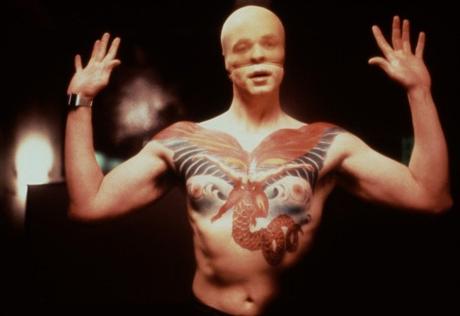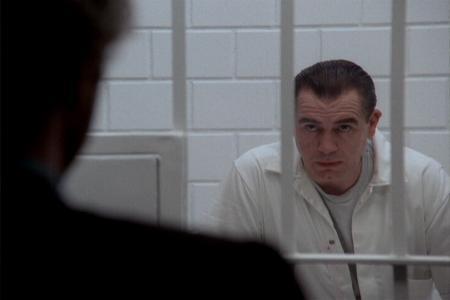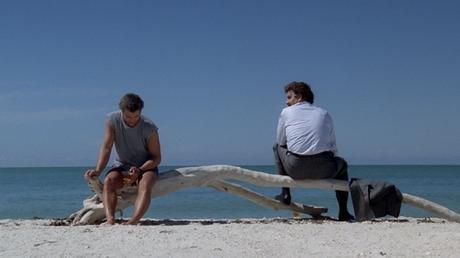
In 1981, author Thomas Harris wrote the first of a series of novels centered around the brilliant and terrifying Dr. Hannibal Lecter. His book Red Dragon attracted the attention of Hollywood. Given that a movie with a similar title had recently bombed, veteran producer Dino De Laurentiis who bought the film rights changed the title of the ultimate adaptation to Manhunter. While this 1986 film failed to make a blip commercially or critically, and future Hannibal Lecter movies have overshadowed it, Manhunter is still a favorite among many film fans.
Former FBI criminal profiler Will Graham is brought out of retirement by his old boss Jack Crawford. His expertise is needed to stop a serial killer known to law enforcement as "the Tooth Fairy". Hoping to gain insight into this killer's world, Graham has to confront the man who retired him to begin with, the psychiatrist turned cannibal Dr. Hannibal Lecktor (nobody seems know why the spelling of his name was changed). With the killer's actions burrowing into Will's mind, Lecktor sees this as the perfect opportunity to see how far he can push his adversary. The former psychiatrist opens a chain of communication with Francis Dollarhyde, the deranged man behind murders. As the bodies rise and Graham has to look deeper into the mind of a madman, one has to wonder if he can come back from the dark places he will have to go.

Today director Michael Mann now holds a solid reputation as one of the greats thanks to hits like Heat, the Last of the Mohicans and Collateral. But in 1986, Manhunter was only his second film and he did not have the respect he currently enjoys. That being said he had plenty of skill he puts on display in crafting this moody and stylish thriller. One of the things often talked about in regards to this film is his use of color. When Will Graham is at home with his family blue is predominantly used, whereas the scenes with Francis Dollarhyde are dominated by a sickly pale green. This separates the world of the film for Graham between a place of safety and refuge and places of disease and madness. This makes perfect sense as the protagonist is a man constantly walking a fine line between justice and madness and there are times we as the audience do not know where he will fall. Not only does this creative decision help on a story telling level but to the overall feel of Manhunter. The look combined with a smooth meditative 80's synth-heavy score truly creates a stylish and moody feel to the flick which is both cool and unnerving at the same time.

As good as he may have been, Mann famously did not have the confidence of producers. The powers that be hoped he would bring in Don Johnson from Mann's hit show Miami Vice, instead he cast William Petersen as the haunted FBI profiler. A number of scenes he saw necessary for the movie were cut out. Luckily Matt, the owner of Black Lodge Video was more than happy to provide the Director's Cut of Manhunter, so I could get an idea of the full vision intended of this cult classic. We see a film which is more violent and puts more emphasis on the juxtaposition between Will Graham and the killer he is hunting.

What this movie has gone down in history for is of course being the cinematic debut of Hannibal Lecter (or Lecktor as he is known as in this film). Those accustomed to the calculating menace and dark charm from Anthony Hopkins and Mads Mikkelsen will likely be taken aback. In playing this role, Brian Cox took inspiration from real life serial killer Peter Manuel AKA the Beast of Birkenshaw. This brings an element of realism to his performance that no other actor has brought to this role. He is not charming or smooth, Cox's Lecter does not hide that he is a vile monster. But he is not the primary villain of the film, that honor goes to Francis Dollarhyde AKA the Tooth Fairy. Brought to life by Tom Noonan, who many reading this will know as Frankenstein's monster from the Monster Squad, he is a man who kills without remorse. As you can guess from this previous role he is a large man which adds an extra bit of intimidation to the character. Driven by the Red Dragon of the painting The Great Red Dragon and the Woman Clothed in Sun, he has no problem with leaving a trail of bodies.
While Manhunter was not a success by any stretch in its 1986 release, it has built a strong cult following. The critics who once dumped on it have in recent years gone back and reevaluated the flick realizing how good it actually was. While it may have been deprived of the box office and critical success the further movies based on Thomas Harris' works, it has found a niche audience who truly appreciate this moody thriller.

